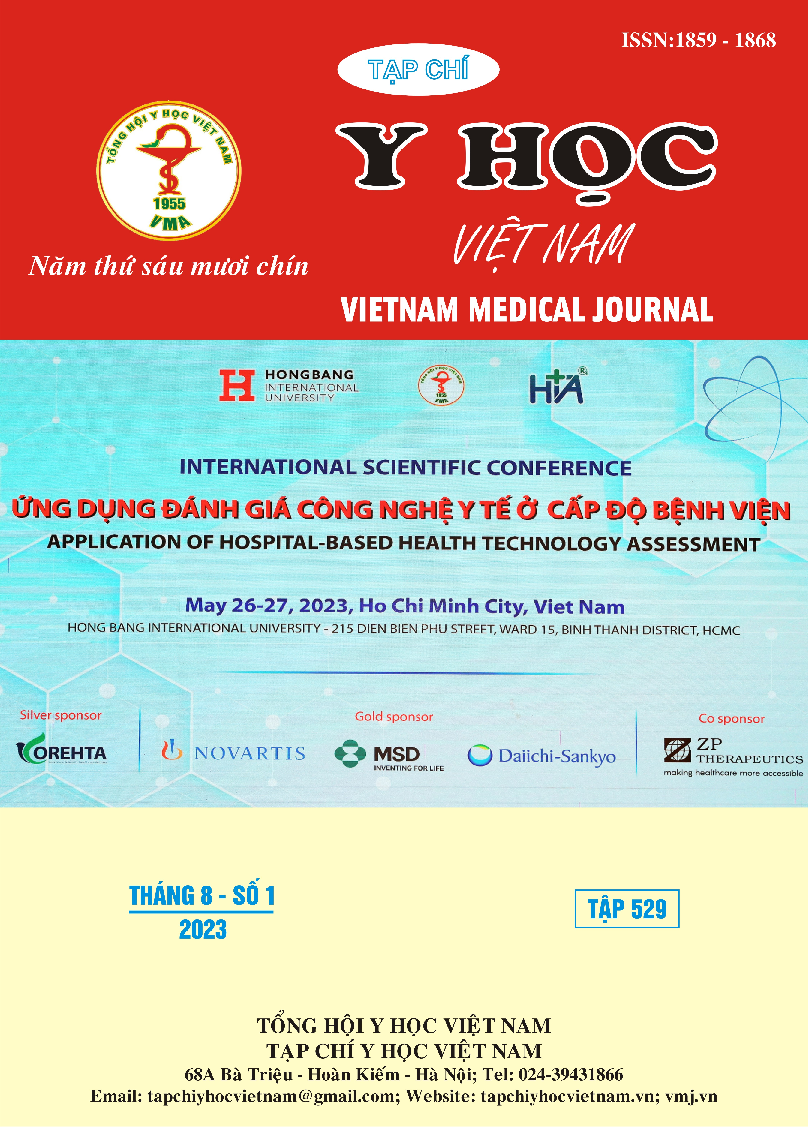KHẢO SÁT BIẾN CHỨNG CỦA THỦ THUẬT THĂM DÒ VÀ CAN THIỆP ĐIỆN SINH LÝ TIM TẠI BỆNH VIỆN ĐA KHOA TỈNH THANH HÓA
Nội dung chính của bài viết
Tóm tắt
Mục tiêu: Nghiên cứu chúng tôi được thực hiện với mục tiêu khảo sát tỉ lệ biến chứng và yếu tố liên quan của thủ thuật thăm dò điện sinh lý tim (TDDSLH) và triệt đốt RLNT bằng RF tại một trung tâm tim mạch tuyến tỉnh. Đối tượng và phương pháp nghiên cứu: Mô tả cắt ngang chùm bệnh trên 144 bệnh nhân thực hiện thủ thuật có theo dõi dọc 01 tháng sau thủ thuật tại Bệnh viện Đa khoa tỉnh Thanh Hoá (từ tháng 02 năm 2022 đến tháng 10 năm 2022). Kết quả nghiên cứu: Biến chứng đường vào mạch máu: Giả phình động mạch đùi 05 (3,5%) trường hợp, tụ máu 14 (9,7%) trường hợp, thông động tĩnh mạch 01 (0,69%) trường hợp và huyết khối 10 (6,9%) trường hợp. Biến chứng rối loạn nhịp: Block nhĩ - thất thoáng qua 03 (2,97%) trường hợp, block nhánh phải hoàn toàn 01 (0,99%) trường hợp. Biến cứng đau 13 (12,8%) trường hợp, cường phế vị 03 (2,97%) trường hợp. Yếu tố liên quan đến khả năng xuất hiện các biến chứng bao gồm: độ tuổi ≥ 70 tuổi, mắc bệnh lý kèm theo (tăng huyết áp), số lượng sheath sử dụng ≥ 3 và kích thước sheath > 8F (p < 0,005).
Chi tiết bài viết
Từ khóa
Thăm dò điện sinh lý học tim, triệt đốt rối loạn nhịp tim bằng năng lượng sóng có tần số radio, biến chứng sau can thiệp.
Tài liệu tham khảo
2. Borggrefe M, Budde T, Podczeck A, Breithardt G. High frequency alternating current ablation of an accessory pathway in humans. J Am Coll Cardiol. 1987;10(3):576-582. doi:10.1016/S0735-1097(87)80200-0
3. Kelm M, Perings SM, Jax T, et al. Incidence and clinical outcome of iatrogenic femoral arteriovenous fistulas. J Am Coll Cardiol. 2002; 40 (2): 291-297. doi:10.1016/S0735-1097(02)01966-6
4. Dimarco JP. Complications in Patients Undergoing Cardiac Electrophysiologic Procedures. Ann Intern Med. 1982;97(4):490. doi:10.7326/0003-4819-97-4-490
5. Scheinman MM, Huang S. The 1998 NASPE Prospective Catheter Ablation Registry. Pacing Clin Electrophysiol. 2000;23(6):1020-1028. doi:10.1111/j.1540-8159. 2000.tb00891.x
6. Calkins H, Yong P, Miller JM, et al. Catheter Ablation of Accessory Pathways, Atrioventricular Nodal Reentrant Tachycardia, and the Atrioventricular Junction: Final Results of a Prospective, Multicenter Clinical Trial. Circulation. 1999; 99(2):262-270. doi: 10.1161/ 01.CIR.99.2.262
7. Hindricks G, ON BEHALF OF THE MULTICENTRE EUROPEAN RADIOFREQUENCY SURVEY (MERFS) INVESTIGATORS OF THE WORKING GROUP ON ARRHYTHMIAS OF THE EUROPEAN SOCIETY OF CARDIOLOGY. The Multicentre European Radiofrequency Survey (MERFS): Complications of radiofrequency catheter ablation of arrhythmias. Eur Heart J. 1993;14(12):1644-1653. doi:10.1093/eurheartj/14.12.1644
8. Feldman A, Voskoboinik A, Kumar S, et al. Predictors of Acute and Long-Term Success of Slow Pathway Ablation for Atrioventricular Nodal Reentrant Tachycardia: A Single Center Series of 1,419 Consecutive Patients: PREDICTORS OF ACUTE AND LONG-TERM SUCCESS OF SLOW PATHWAY ABLATION. Pacing Clin Electrophysiol. 2011; 34(8):927-933. doi:10.1111/j.1540-8159. 2011. 03092.x
9. Kobza R, Kottkamp H, Piorkowski C, et al. Radiofrequency ablation of accessory pathways: Contemporary success rates and complications in 323 patients. Z F�r Kardiologie. 2005;94(3):193-199. doi:10.1007/s00392-005-0202-9
10. Tamanaha Y, Sakakura K, Taniguchi Y, et al. Comparison of Postcatheterization Pseudoaneurysm between Brachial Access and Femoral Access. Int Heart J. 2019;60(5):1030-1036. doi:10.1536/ihj.18-551


